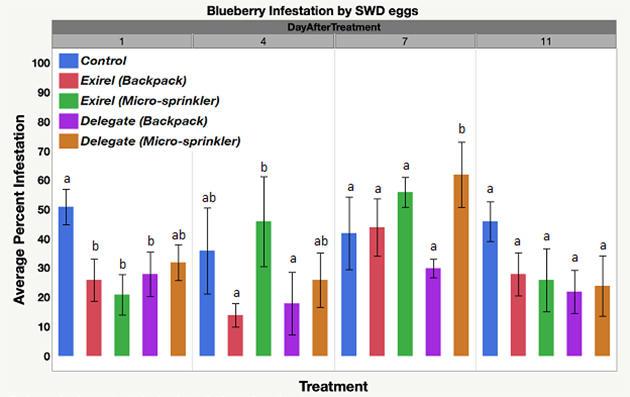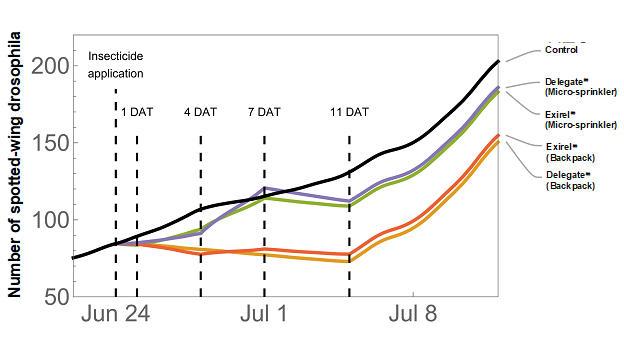Key findings
- Exirel® and Delegate® applied by backpack sprayer provided better control than application by micro-sprinkler.
- However, model simulations indicated that micro-sprinkler applications of Exirel® and Delegate® had a suppressive effect on SWD.
Introduction
Blueberry growers have asked whether micro-sprinklers can deliver insecticides to a blueberry canopy to reduce egg-laying by spotted-wing drosophila (SWD) in the developing crop. Growers must control SWD because rapid fruit infestation spikes can cause large losses at packing houses.
Micro-sprinklers are commonly used in blueberry production for irrigation, frost protection and crop cooling. Would micro-sprinklers also be an efficient insecticide application tool when high SWD infestations require a rapid response? Oregon State University Extension researchers set out to answer that question.
Our study compared on-farm micro-sprinkler application of Exirel® (cyantraniliprole) and Delegate® (spinetoram) in ‘Duke’ blueberry to backpack sprayer application of the same chemicals. The 2020 study on a university farm in Corvallis, Oregon, included an untreated control.
Researchers applied the insecticides during a mid-June SWD population increase. They followed label instructions for application rates. Seven blueberry bushes received the insecticide treatment, and researchers collected data from the five middle bushes.
To monitor egg-laying after insecticide applications, researchers released five mated female and five male 8-day-old SWD adults into mesh bags placed over clusters of 10–20 blueberries.
The berries were retrieved, and the bags were replaced with five mated SWD pairs onto similar fruiting branches on days four, seven, and 11 after the insecticide applications. Researchers delivered the insecticides via fogger misters using Venturi injectors (Mazzei® Model 584, Mazzei Injector Company LLC, Bakersfield, California). (Figures 1, 2). The researchers then examined the berries in a lab for eggs one, four, seven and 11 days after the insecticide applications.
Backpack applications more consistently suppressed SWD populations than micro-sprinklers. On day one, although there was a numerical difference, there was no statistically significant difference in the percentage of egg infestations among any treatments. All were lower than the untreated control except for Delegate® applied by micro-sprinkler.
There were numerical differences among the treatments in the number of infested berries on day four, but none of these differences were statistically significant. On day seven, a statistically significant greater number of berries treated with Delegate® by micro-sprinkler were infested than berries treated with backpack-sprayed Delegate®.
When comparing berries treated with Delegate® applied by backpack sprayer to berries treated with Exirel® applied by either technique, researchers found numerical differences but no statistical difference. There was no significant difference among any infestation rates (21% to 28%) on day 11.
Researchers fed field study data into an SWD population model to estimate subsequent population growth for each delivery method. We incorporated the field data with SWD population model because the model allows us to directly compare fruit infestation and population growth under different insecticide treatments and application methods.
Model simulations of SWD populations indicated that growers applying Exirel® and Delegate® by backpack sprayer could expect a nearly 50% reduction in juvenile life stages from either insecticide and a nearly 20% reduction when applying by micro-sprinkler (Figure 4). This may have been due to the difference in action between the backpack sprayer and the micro-sprayer. Micro-sprayers use gravity and wind to cover the crop. Backpack sprayers provide greater overall coverage. In this study, backpack applications continued until just before the product runoff point. Both sides of the leaves and berry clusters were more fully covered by the backpack applications. Overall, the backpack applications provided consistent suppression of SWD populations. Micro-sprinklers were less consistent in suppressing SWD populations. The number of micro-sprinkler nozzles and their positions could be adjusted based on the blueberry canopy structure.
Deployment of more micro-sprinklers per bush would provide greater canopy coverage and likely increase the efficiency of such applications.
Acknowledgment
Thanks to FMC Corporation and Corteva Agriscience, for their cooperation and for providing insecticides, and lab members Aleksandar Bozaric, Canessa D. Thomas, Maxwell Moeller and Katherine G. Oppenheimer, for fieldwork support.
Resources
Liu, Z., X. Jiao, C. Zhu, G.G. Katul, J. Ma, and W. Guo. 2021. Micro-climatic and crop responses to micro-sprinkler irrigation. Agricultural Water Management.
Mermer, S., G. Tait, F. Pfab, E. Mirandola, A. Bozaric, C.D. Thomas, M. Moeller, K.G. Oppenheimer, L. Xue, L. Wang, and V.M. Walton. 2022. Comparative Insecticide Application Techniques (Micro-Sprinkler) Against Drosophila suzukii Matsumura (Diptera: Drosophilidae) in Highbush Blueberry. Environmental Entomology.
Rieger, M. 1993. Under- and Overtree Micoro-sprinkler Irrigation for Frost Protection of Peaches. HortTechnology.
Yang, F. H., D.R. Bryla, S.T. Orr, B.C. Strik, and Y. Zhao. 2020. Thermal Cooling with Sprinklers or Micro-sprinklers Reduces Heat Damage and Improves Fruit Quality in Northern Highbush Blueberry. HortScience.








